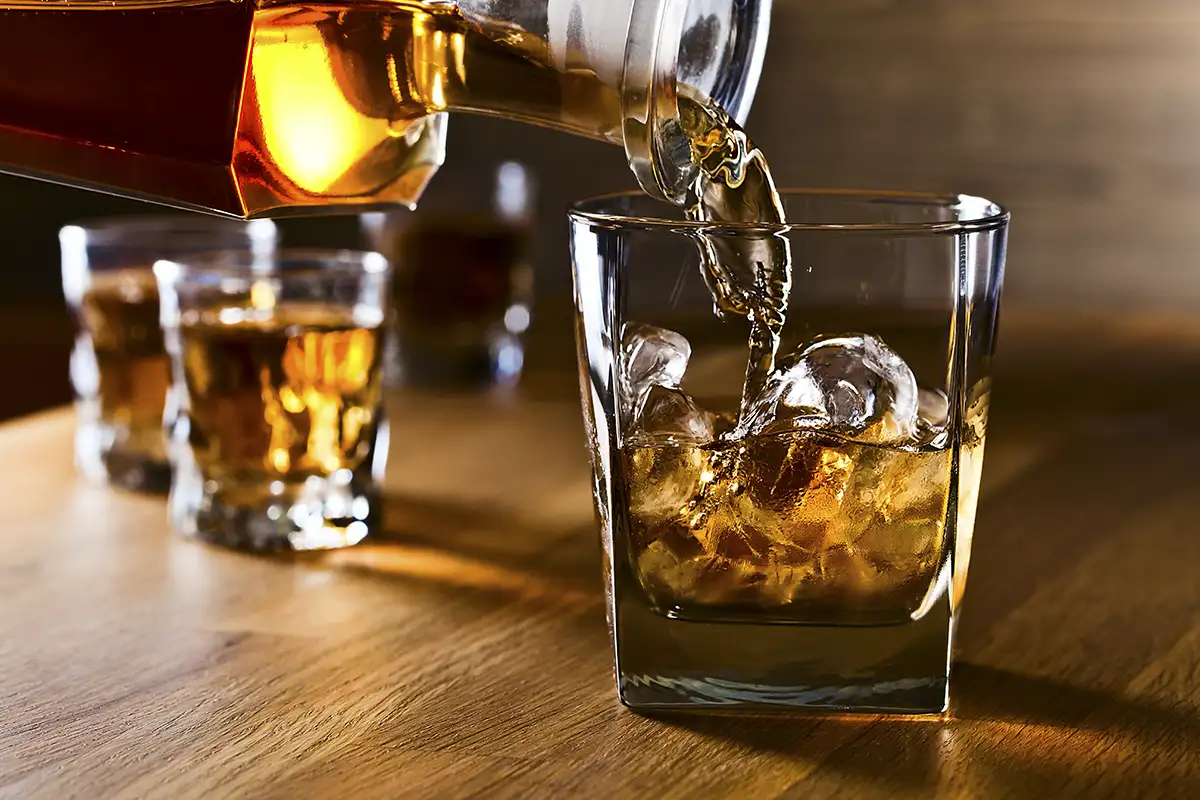What Is Bourbon Made From? A Deep Dive into an American Spirit

August 9, 2024

What We’ll Cover in This Piece:
- The Definition of Bourbon
- The Primary Ingredients Bourbon Is Made From
- The Role of Water in Making Bourbon
- The Fermentation Process of Bourbon
- The Distillation of Bourbon
- Aging Bourbon in Oak Barrels
- Bottling and Regulations of Bourbon
- Common Misconceptions Around What Bourbon Is Made From
- A Final Word on What Bourbon Is Made From
The Definition of Bourbon
The Primary Ingredients Bourbon Is Made From

The foundation of what bourbon is made from lies in its primary ingredients, each contributing to the spirit's distinct character and flavor. Understanding what bourbon is made from begins with exploring these essential components.
Corn
Corn is the cornerstone of any bourbon. Bourbon's mash bill must consist of at least 51% corn by law. Corn imparts a sweetness to the whiskey, distinguishing bourbon from other types of whiskey like Scotch or Irish whiskey, which typically use barley as their primary grain. The high corn content answers a significant part of the question: what is bourbon made from?
Corn's influence on bourbon is profound. It provides the necessary fermentable sugars and contributes to the spirit's smooth texture and slightly sweet taste. The choice of corn, whether it's yellow dent corn, heirloom varieties, or organic options, can further affect the flavor profile. Distilleries often source high-quality corn, ensuring that this primary ingredient meets their standards for producing exceptional bourbon.
Rye, Barley, and Wheat
While corn is the primary grain, other grains play crucial supporting roles. Rye adds a spicy, robust character to bourbon, making it more complex and flavorful. Rye-heavy bourbons are known for their bold, peppery notes, which balance the sweetness of the corn.
Barley, usually malted, is another critical ingredient because it contains enzymes that convert starches into fermentable sugars during mashing. This enzymatic activity is vital for creating the wort, the liquid extracted from the mash that contains the sugars needed for fermentation. Barley adds subtle, nutty, and malty notes to the overall flavor.
Wheat, used in some bourbon recipes, contributes a softer, smoother profile. Wheated bourbons are often described as having a gentle sweetness and a creamy mouthfeel, making them highly approachable for those new to bourbon.
The specific combination of these grains, known as the mash bill, varies among distilleries, giving each bourbon a unique flavor. Distillers carefully select and balance these grains to achieve their desired flavor profile, ensuring that each sip of bourbon is a testament to their craftsmanship.
The Role of Water in Making Bourbon
When considering what bourbon is made from, one must acknowledge the critical role of water. Many distilleries are located in Kentucky, where limestone-filtered water is abundant. This water is free from iron, which can impart undesirable flavors, and rich in minerals that benefit the fermentation process.
Limestone-filtered water is particularly valued because it contains calcium and magnesium, which aid in fermentation and help extract more flavors from the grains. The mineral composition of the water can subtly influence the final product's taste, adding to the complexity of the bourbon.
Distilleries often take great care to ensure that their water source is pristine and consistent. Some even have their own wells or access to natural springs, guaranteeing that the water used in their bourbon production is of the highest quality. The significance of water cannot be overstated, as it impacts every stage of the bourbon-making process, from mashing to fermentation to proofing down the final product before bottling.
The Fermentation Process of Bourbon

With many spirits and alcoholic beverages, the magic begins with fermentation. During this step, the grains are ground into a coarse meal and mixed with water to create a mash. Afterward, the mash is heated to convert the starches into sugars. Once cooled, yeast is added to the mash, initiating fermentation. This process converts the sugars into alcohol and carbon dioxide, forming a beer-like liquid known as "distiller's beer." The type of yeast and the conditions of fermentation significantly influence the final flavor of the bourbon.
The choice of yeast strain is a critical decision for distillers. Different yeast strains produce different flavor compounds, known as congeners, which contribute to the complexity of the bourbon. Some distilleries use proprietary yeast strains, carefully cultivated and maintained over generations, to create their signature flavor profiles.
Fermentation typically takes place in large, open-top wooden or stainless steel fermenters. The temperature and duration of fermentation are carefully controlled to optimize the production of alcohol and flavor compounds. A longer, cooler fermentation might yield more fruity and floral notes, while a shorter, warmer fermentation can produce more robust and spicy flavors.
The Distillation of Bourbon
Distillation is the next crucial step in understanding what bourbon is made from. The fermented mash is transferred to a still and heated to separate alcohol from the water and other components. This process typically occurs in a column still followed by a doubler or pot still, which refines the alcohol further. The resulting distillate, known as "white dog" or "new make spirit," is clear and potent, yet not quite bourbon until it undergoes aging.
During distillation, the goal is to concentrate the alcohol while retaining desirable flavor compounds and eliminating unwanted impurities. The distillation process can significantly influence the bourbon's character, as different stills and distillation techniques can produce varying results.
Using a column still allows for continuous distillation, providing efficiency and consistency in the production process. The doubler or pot still, used in conjunction with the column still, helps refine the spirit, enhancing its flavor and smoothness. The distiller's skill and experience play a crucial role in determining the quality of the distillate and, ultimately, the final bourbon.
Aging Bourbon in Oak Barrels

Since straight bourbon legally needs to age for at least two years in new charred oak barrels, aging is the most defining step in what bourbon is made from. The charring of the barrels, particularly, caramelizes the wood sugars, imparting rich flavors and colors to the spirit. Over time, the bourbon interacts with the wood, absorbing flavors like vanilla, caramel, and spice while mellowing out harsher alcohol notes.
Several factors, including the climate, the location of the barrels in the warehouse, and the duration of aging influence the aging process. In Kentucky, where many bourbons are produced, the hot summers and cold winters cause the bourbon to expand and contract within the barrels, maximizing its interaction with the wood. This process, known as the "breathing" of the barrels, enhances the complexity and depth of the bourbon's flavor.
Distilleries often rotate their barrels within the warehouse to ensure even aging. Barrels at the top of the warehouse typically age faster due to higher temperatures, while those at the bottom age more slowly. Distillers taste and evaluate to determine the optimal aging period for each batch and when to bottle the bourbon.
Bottling and Regulations of Bourbon
Once the bourbon has aged to the distiller's satisfaction, the liquid is removed from the barrels and bottled. Regulations ensure that bourbon stays unadulterated by additives; its flavors must come solely from the grains, water, yeast, and barrel. Understanding these strict regulations is essential to fully grasp what bourbon is made from.
Before bottling, the bourbon may be filtered to remove any impurities or particulate matter. Some distilleries choose to bottle their bourbon at cask strength, without dilution, to preserve its full flavor and intensity. Others may proof down the bourbon by adding water to achieve the desired alcohol content, typically between 80 and 100 proof.
Bourbon labeling is also strictly regulated. Terms like "straight bourbon," "bottled in bond," and "small batch" have specific legal definitions that must be adhered to. These regulations ensure transparency and consistency, allowing consumers to know exactly what they are getting when purchasing a bourbon bottle.
Common Misconceptions Around What Bourbon Is Made From

Understanding what bourbon is made from and the intricacies of its production can help dispel some common misconceptions that may affect how restaurants, bars, and small business owners present and serve bourbon. Here are a few of the most prevalent myths and the truths behind them:
All Whiskey is Bourbon
A frequent misunderstanding is that all whiskey is bourbon. While all bourbon is whiskey, not all whiskey qualifies as bourbon. The distinction lies in the specific requirements that define bourbon, such as being made in the United States, containing at least 51% corn, and aging in new charred oak barrels. Other whiskeys, like Scotch, Irish whiskey, and rye, have their own unique ingredients and production methods.
Understanding this difference can enhance how you educate your customers and curate your whiskey selection. Highlighting the unique aspects of bourbon can help your patrons appreciate what sets it apart from other whiskeys.
Bourbon Must Come from Kentucky
Although Kentucky is renowned for its bourbon production, bourbon can be made anywhere in the United States. Kentucky's limestone-filtered water and ideal aging conditions contribute to the high quality of its bourbon, but excellent bourbons are also produced in other states like Tennessee, Indiana, and even New York.
Promoting a variety of bourbons from different states can introduce your customers to a broader range of flavors and styles, showcasing the diversity within bourbon production.
Bourbon and Tennessee Whiskey are the Same
Tennessee whiskey and bourbon share many similarities, but there is a crucial difference: the Lincoln County Process. Tennessee whiskey, like Jack Daniel’s, undergoes an additional charcoal filtering process before aging, which mellows the spirit. This process is not used in bourbon production.
Clarifying this distinction can help customers understand and appreciate the unique characteristics of Tennessee whiskey and bourbon and why they might prefer one over the other.
All Bourbons are High Proof
Another common misconception is that all bourbons are high-proof and, therefore, too intense for some drinkers. While high-proof bourbons are available, many are bottled at 80 to 100 proof, making them smooth and enjoyable for a wide range of palates.
Offering a selection of bourbons with varying proofs can cater to different customer preferences, ensuring there is something for everyone, from the novice to the seasoned bourbon enthusiast.
A Final Word on What Bourbon Is Made From
Ready To Build Your Best Bourbon Menu?
More than 20,000 venues around the world use Untappd for Business for menus, analytics, and promotion of their venue.
Schedule a demo or start your 7 day free trial – no credit card required.
